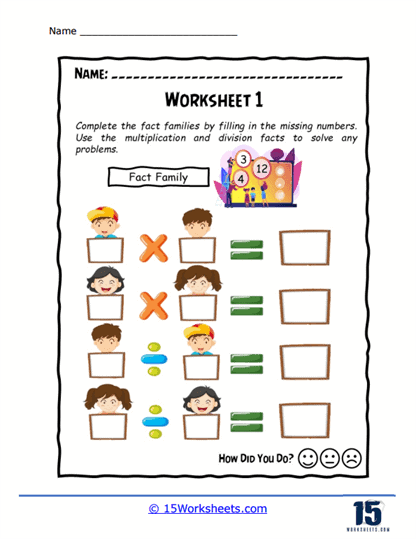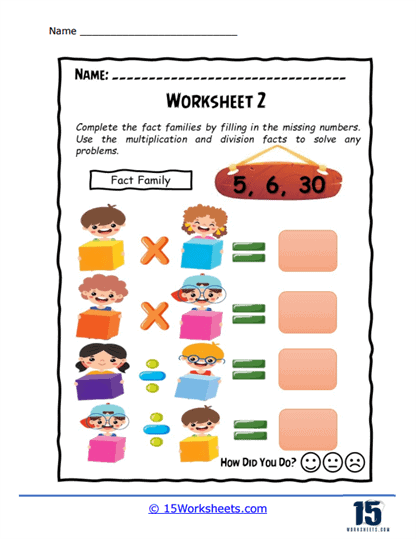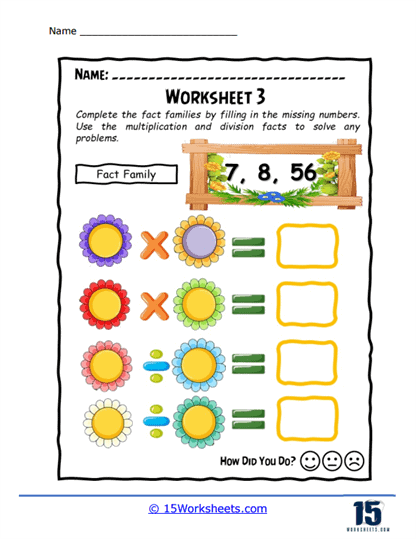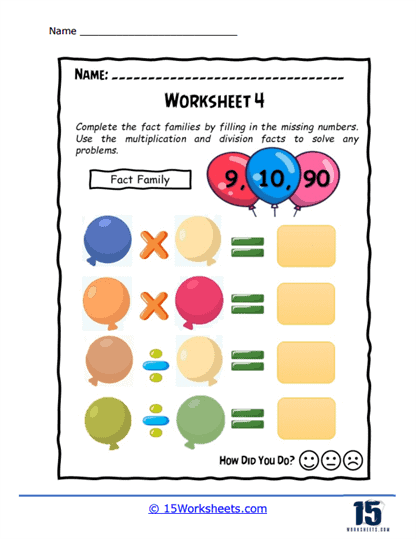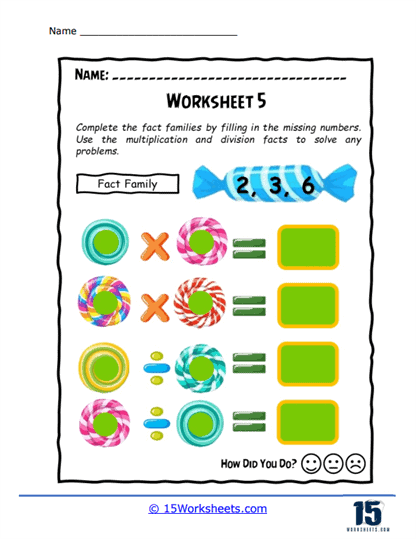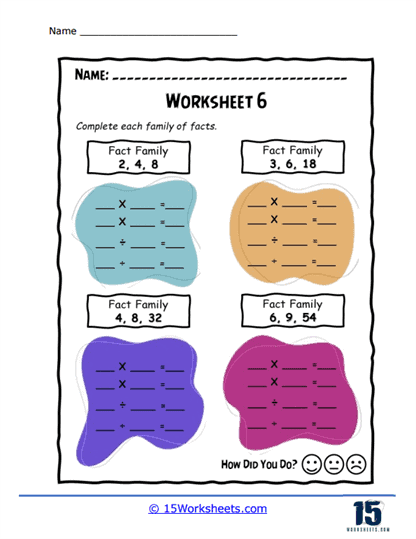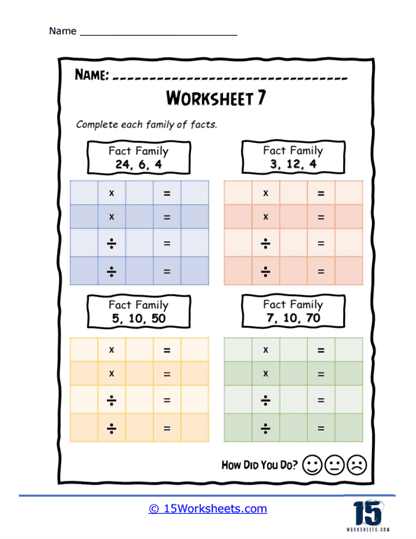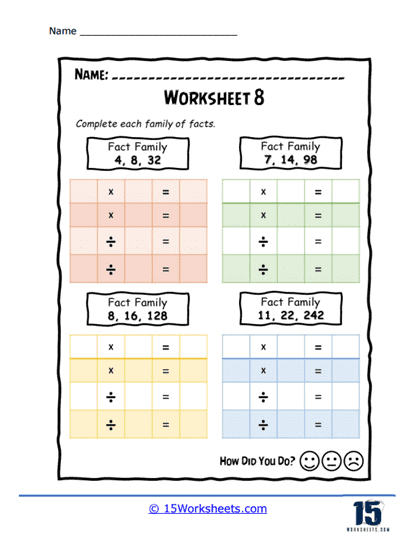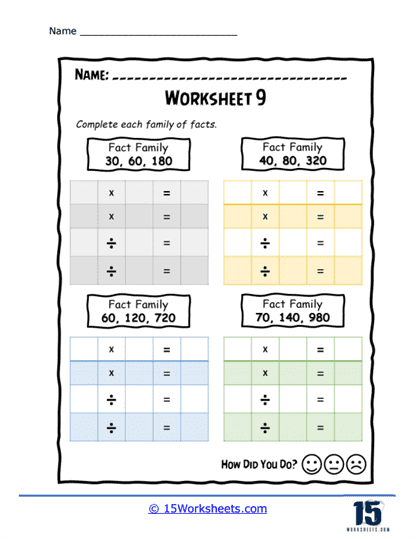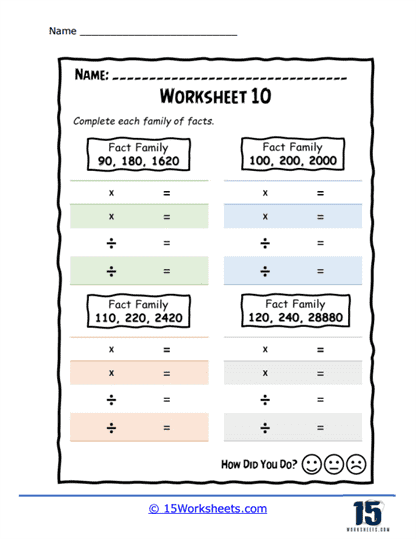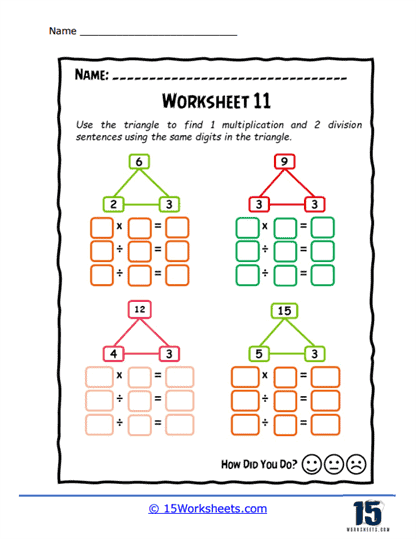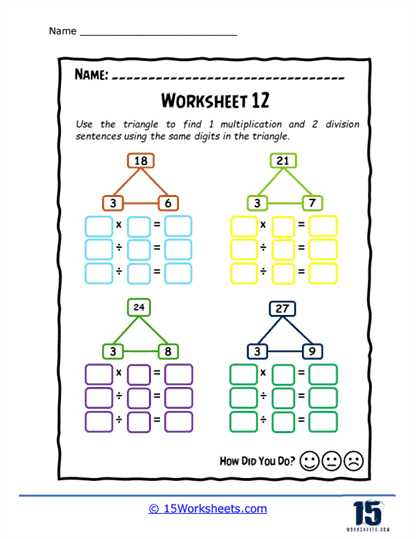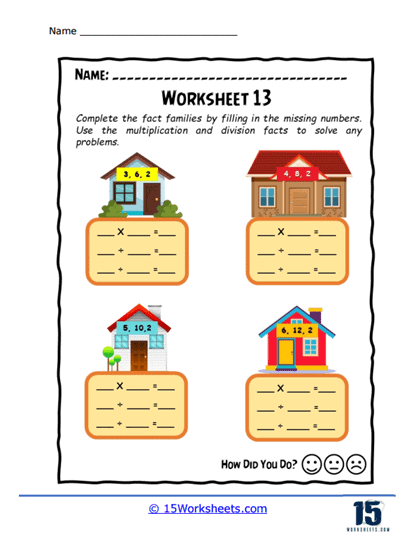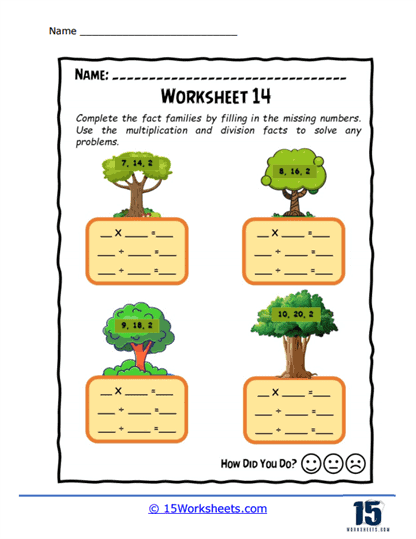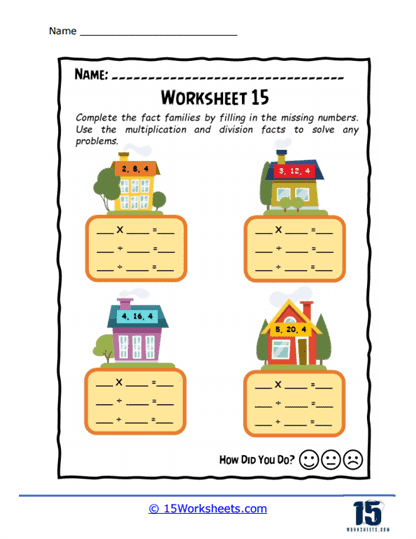Multiplication and Division Fact Families Worksheets
All About These 15 Worksheets
These worksheets help students learn to bridge the conceptual gap between multiplication and division. These worksheets highlight the intrinsic relationship between these operations, demonstrating that multiplication can be seen as repeated addition, while division is essentially the process of finding how many times one number is contained within another. By presenting related facts together, such as 4 x 5 = 204 x 5 = 20, 5 x 4 = 205 x 4 = 20, 20 ÷ 4 = 520 ÷ 4 = 5, and 20 ÷ 5 = 420 ÷ 5 = 4, students gain a clearer understanding of how numbers interact in a structured system. This approach not only strengthens their grasp of arithmetic operations but also develops their ability to think critically and recognize patterns-skills that extend beyond the math classroom.
The structure of these worksheets is intentionally designed to cater to diverse learning needs, incorporating a mix of exercises, such as fill-in-the-blank questions, matching pairs, and word problems. These activities provide both repetition for skill mastery and opportunities for applied problem-solving, ensuring that students develop fluency while understanding the “why” behind their calculations. Additionally, such worksheets often include visual aids, such as arrays or number lines, which are especially helpful for younger learners or those who benefit from a more tactile approach to learning. This combination of theoretical and practical elements makes fact family worksheets versatile tools that can be adapted to different teaching methodologies, whether in a traditional classroom setting, during homeschooling, or for individual practice.
They not only reinforce basic arithmetic skills but also lay the groundwork for more advanced mathematical concepts, such as fractions, ratios, and algebra. By mastering fact families, students develop confidence in their computational abilities, which can reduce math anxiety and encourage a positive attitude toward the subject. Furthermore, these worksheets are instrumental in promoting number sense-a deep understanding of numbers and their relationships-which is a cornerstone of mathematical literacy. In various teaching contexts, from differentiated instruction to group activities, these worksheets play a crucial role in fostering collaboration, critical thinking, and a lifelong appreciation for mathematics.
What Are Fact Families?
A fact family is a group of related mathematical facts that involve the same set of numbers. These relationships demonstrate how different mathematical operations are interconnected, making them a foundational concept in arithmetic. For multiplication and division, fact families are built upon the inverse relationship between these two operations. Understanding fact families helps students see how numbers and operations work together, rather than viewing them as separate skills. This interconnected perspective is crucial for building number sense and fluency in problem-solving.
For instance, consider the numbers 3, 6, and 18. These numbers form a fact family that illustrates their mathematical relationships. In multiplication, you can combine these numbers to get the following facts: 3 x 6 = 18 and 6 x 3 = 18. On the flip side, division shows how the product, 18, can be divided to return to its original factors: 18 ÷ 3 = 6 and 18 ÷ 6 = 3. This pattern highlights the inverse nature of multiplication and division-where one operation undoes the other. Recognizing these patterns is an essential step in developing mathematical reasoning.
3 x 6 = 18
6 x 3 = 18
18 ÷ 3 = 6
18 ÷ 6 = 3
The concept of fact families is not just a tool for performing calculations; it also fosters a deeper understanding of mathematics. By exploring these relationships, students can grasp the inherent symmetry in numbers and operations. This understanding builds confidence as students move from basic arithmetic to more advanced topics. Moreover, learning about fact families provides a framework for tackling complex problems by showing how various operations can be used together to find solutions. In this way, fact families serve as a bridge between concrete number skills and abstract mathematical thinking.
The Benefits of These Exercises
Understanding Relationships Between Operations
Fact family worksheets offer a valuable opportunity for students to explore the deep connections between multiplication and division. By seeing how these operations are inverse processes, students begin to recognize patterns and relationships in numbers that go beyond rote memorization. For instance, when students understand that 4×5=204×5=20 is directly related to 20 ÷ 4=520 ÷ 4=5, they realize that division can “undo” multiplication and vice versa. This reduces the mental strain often associated with solving mathematical problems, as students can rely on these relationships to simplify their thought processes.
This understanding is not just about performing operations faster but also about enhancing cognitive efficiency. When students grasp how multiplication and division are linked, they are better equipped to solve real-world problems that require the use of these operations interchangeably. Moreover, this interconnected view of arithmetic fosters mathematical reasoning, encouraging students to approach math as a system of relationships rather than isolated rules or equations. Fact family worksheets, therefore, play a critical role in teaching students how to think mathematically, laying the groundwork for more advanced problem-solving skills.
Building Fluency
Practicing multiplication and division fact families repeatedly helps students develop speed and accuracy, two critical components of mathematical fluency. As students work through various combinations of numbers, they internalize the relationships between these operations, which allows them to solve problems more efficiently. For example, recognizing that 6×7=426×7=42 also provides immediate knowledge that 42 ÷ 6=742 ÷ 6=7, reducing the time needed to perform separate calculations. This automaticity frees up mental resources for more complex tasks, such as multi-step problem-solving or reasoning about larger numbers.
Fluency is not only about speed; it also builds confidence. When students feel secure in their ability to recall and use mathematical facts quickly, they are more likely to take on challenging problems without hesitation. Additionally, the repeated exposure provided by worksheets strengthens memory retention, ensuring that these skills remain accessible over time. Fact family worksheets serve as a structured way to achieve this practice, giving students the consistent exposure needed to build lasting mathematical competence.
Enhancing Problem-Solving Skills
Fact families encourage students to think critically and explore multiple approaches to solving a problem. For instance, if a student knows that 4 x 5 = 20, they can deduce 20 ÷ 4 = 5 and even extend this understanding to similar problems involving related numbers. This ability to see multiple pathways to a solution is a hallmark of strong problem-solving skills. Fact family worksheets challenge students to apply what they know in diverse scenarios, promoting flexibility in their thinking.
This critical thinking extends beyond mathematics, as problem-solving is a transferable skill applicable in science, engineering, and everyday life. By practicing with fact families, students learn to analyze problems, identify patterns, and make logical deductions-skills that are essential in virtually every academic and professional field. Fact family worksheets provide a structured way to nurture these abilities, helping students become not just competent mathematicians but also effective thinkers.
Promoting Number Sense
Working with fact families helps students see numbers as interconnected and flexible rather than static or isolated. This perspective is essential for developing number sense, which refers to an intuitive understanding of numbers and their relationships. For example, when students learn that 7 x 8 = 56 and 56 ÷ 7 = 8, they begin to see that numbers can be decomposed and recombined in meaningful ways. This understanding lays the foundation for advanced concepts such as fractions, ratios, and proportional reasoning.
Number sense also enhances students’ ability to estimate and check their work. When students view numbers as part of a network of relationships, they can more easily detect errors and reason about whether their answers make sense. Fact family worksheets help cultivate this skill by consistently reinforcing the idea that numbers and operations are interrelated, fostering a deeper and more intuitive grasp of mathematics as a whole.

